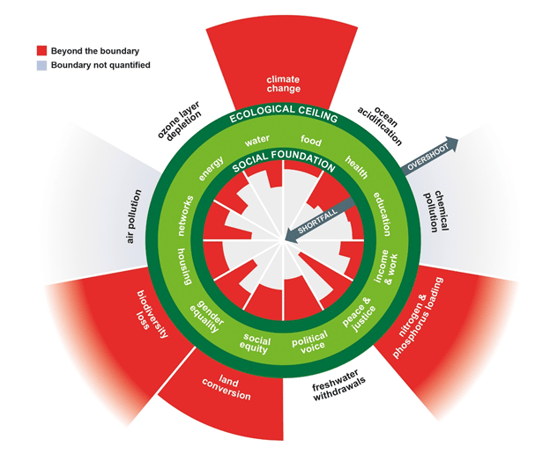Economies and supply chains are complicated. Sometimes it feels like these systems that we are all obligated to participate in require a 4-year college degree to understand. What we do know is that there is no universal "right answer" or solution, and that there are a lot of very intelligent individuals around the world who are constantly working to make these systems better and simpler.
We hear a lot about systemic change focused on the idea of a circular economy. This is an idea that redefines how we see business, society, and the environment and steers us toward the idea of decoupling growth from the consumption of finite resources and provides pathways for eliminating waste. One specific economic model that holds many of these same values is Doughnut Economics, designed and established by senior researcher and economist, Kate Raworth.
Doughnut Economics
The name “Doughnut Economics” derives from its diagram (image below), which closely mimics the well-known sweet treat. Raworth's visual model aims to demonstrate the safe operating space for humanity that uses human well-being as the currency, versus the dollar. The bottom line is reformulated to prioritize meeting the needs of all people, while still operating within the planetary boundaries. Raworth refers to these boundaries in her model as the ecological ceiling and the social foundation. The goal of doughnut economics is to stay within these two boundaries, in a place referred to as, "the safe and just space for humanity".
Staying above this social foundation would mean everyone having access to water, food, energy, healthcare, education, income, work, and so on. Currently, 1.8 billion people do not have access to adequate sanitation and 759 million adults are illiterate. Upwards of 37 million people are struggling with hunger in just the United States. As a society we are falling short of "meeting the needs of all people" by quite a large margin in every category. Staying below the ecological ceiling would mean operating within the safe space for climate change, ocean acidification, chemical pollution, nitrogen and phosphorous loading, and five other categories. We have already exceeded the healthy limits in 4 out of 9 categories, with 2 of them not having been quantified yet. Nearly all the world's economies are currently measured using GDP (Gross Domestic Product), which has set the stage for global inequities and economic instability as Raworth has demonstrated.

Image: Kate Raworth and Christian Guthier/The Lancet Planetary Health
We are conditioned to believe that a healthy economy must be measured by dollars and trading goods. Traditional economies almost entirely miss social health and the exchange of social goods. Raising of families and human connection is awarded zero value, while manufacturing and production dominates the scene as the proponent for unending economic growth.
Of course, so many of the systems we currently depend on around the globe rely on these financial institutions to operate. An overnight shift from measuring by GDP to human well-being is unreasonable, so what can we do instead? Well, it is important to remember that to stay above this social foundation set out by Raworth, things like education, income and work, housing, and many others are still necessary. By no means do we want to cut industry out of the equation as it is a bedrock for many of the resources we all count on. Instead, we should start having conversations about growth and what it means for us all. Starting to address humanity’s well-being and the environments health as our measures for success, rather than GDP, will start us on a path in the right direction.
Another barrier we might face is changing our industry or workplace culture. Again, so many of us are conditioned to pursue unending growth and that is reflected in many of the businesses we know today. While you may not have control over the bottom-line, one way to make progress is being an advocate for well-sourced and environmentally conscious materials and ingredients. As you can see in the diagram above, planetary boundaries such as climate change, chemical pollution, air pollution, biodiversity loss, and others can be largely impacted by manufacturing. The materials we source, chemicals we incorporate, and energy we use have global consequences. Promoting recycled or repurposed materials, sourcing less-toxic or non-toxic substances, and spearheading initiatives that help eliminate waste can have an unbelievably large benefit for the environment.
While no economic model is flawless, Raworth’s Doughnut presents a range of ideas that helps us think about how we can create change. The global exchange of goods is an essential part of life as we know it. However, there are collective actions that can lead us to more equitable economic systems, and ultimately that "safe and just space for humanity" that serves everyone. Reach out to us today to learn about how Toxnot can help you reach your Doughnut goals!
Learn more about Doughnut Economics with these resources:
Change the Goal - Doughnut Economics
New economic model could end inequality
The Guardian | Doughnut Economics
Why it's time for 'Doughnut Economics' | Kate Raworth | TEDxAthens
A Doughnut for the Anthropocene

